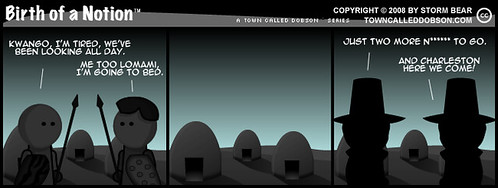 click to enlarge The first Europeans to use African slaves in the New World were the Spaniards who sought auxiliaries for their conquest expeditions and laborers on islands such as Cuba and Hispaniola, where the alarming decline in the native population had spurred the first royal laws protecting the native population. The first African slaves arrived in Hispaniola in 1501. In 1452, Pope Nicholas V issued the papal bull Dum Diversas, granting Afonso V of Portugal the right to reduce any "Saracens, pagans and any other unbelievers" to hereditary slavery. This approval of slavery was reaffirmed and extended in his Romanus Pontifex bull of 1455. These papal bulls came to serve as a justification for the subsequent era of slave trade and European colonialism. The followers of the church of England and Protestants did not use the papal bull as a justification. Increasing penetration into the Americas by the Portuguese created more demand for labor in Brazil--primarily for farming and mining. Slave-based economies quickly spread to the Caribbean and the southern portion of what is today the United States. These areas all developed an insatiable demand for slaves. As European nations grew more powerful, especially Portugal, Spain, France and England, they began vying for control of the African slave trade, with little effect on the local African and Arab trading. Great Britain's existing colonies in the Lesser Antilles and their effective naval control of the Mid Atlantic forced other countries to abandon their enterprises due to inefficiency in cost. The English crown provided a charter giving the Royal African Company monopoly over the African slave routes until 1712. The Atlantic slave trade peaked in the late 18th century, when the largest number of slaves were captured on raiding expeditions into the interior of West Africa. These expeditions were typically carried out by African kingdoms, such as the Oyo empire (Yoruba), Kong Empire, Kingdom of Benin, Kingdom of Fouta Djallon, Kingdom of Fouta Tooro, Kingdom of Koya, Kingdom of Khasso, Kingdom of Kaabu, Fante Confederacy, Ashanti Confederacy, and the kingdom of Dahomey. Europeans rarely entered the interior of Africa, due to fear of disease and moreover fierce African resistance. Before the arrival of the Portuguese, slavery had already existed in Kingdom of Kongo. Despite its establishment within his kingdom, Afonso I of Kongo believed that the slave trade should be subject to Kongo law. When he suspected the Portuguese of receiving illegally enslaved persons to sell, he wrote letters to the King João III of Portugal in 1526 imploring him to put a stop to the practice. The kings of Dahomey sold their war captives into transatlantic slavery, who otherwise would have been killed in a ceremony known as the Annual Customs. As one of West Africa's principal slave states, Dahomey became extremely unpopular with neighboring peoples. Like the Bambara Empire to the east, the Khasso kingdoms depended heavily on the slave trade for their economy. A family's status was indicated by the number of slaves it owned, leading to wars for the sole purpose of taking more captives. This trade led the Khasso into increasing contact with the European settlements of Africa's west coast, particularly the French. Benin grew increasingly rich during the 16th and 17th centuries on the slave trade with Europe; slaves from enemy states of the interior were sold, and carried to the Americas in Dutch and Portuguese ships. The Bight of Benin's shore soon came to be known as the "Slave Coast". Disclaimer:
|
Monday, March 24, 2008
Black History: The Slave Coast
Posted by
Storm Bear
at
6:37 AM
![]()
Labels: black history, cartoons, comics, racism, slave trade, slavery, webcomics
Subscribe to:
Post Comments (Atom)








0 comments:
Post a Comment